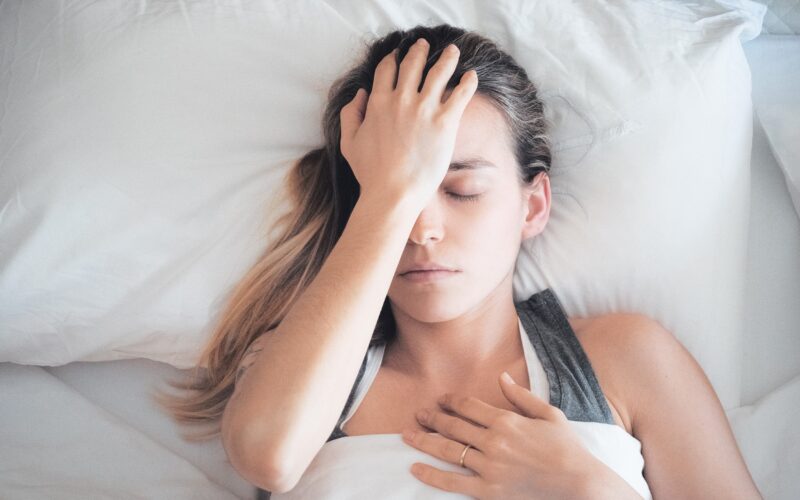For anyone who has experienced a migraine before, the word alone is enough to make them run for the hills. As headaches so painful that you cannot complete normal functions, migraines are one of the most awful, common physical conditions one can experience.
As a migraine sufferer for more than 15 years, I know the agony of this malady. Women are disproportionately affected—experiencing a threefold higher likelihood of having a migraine in a one-year period compared to men, and twofold higher in lifetime incidence [1]. The exact nature of the relationship of sex steroid hormones and migraines is still not fully known and is being studied, but women of reproductive age seem to be affected the most. However, interestingly, migraines tend to improve in both frequency and severity during pregnancy, breastfeeding, and post-menopause. This leads to the conclusion that sex steroids and the menstrual cycle play critical roles in women’s migraines.
Migraines vs headaches: What’s the difference?
Let’s start by answering, what is a migraine and how is it different from a headache? According to WebMD, “A migraine is a strong headache that often comes with nausea, vomiting, and sensitivity to light. It can last hours or days.” Migraines can present with vision-blurring sensations called “aura.” These symptoms stem from your nervous system.
Aura symptoms often look like:
- Seeing black dots, wavy lines, flashes of light, or things that aren’t there (hallucinations)
- Having tunnel vision
- Not being able to see at all
- Having tingling or numbness on one side of your body
- Not being able to speak clearly
- Having a heavy feeling in your arms and legs
- Having ringing in your ears
- Noticing changes in smell, taste, or touch
Why do women get migraines before (or during) their periods?
While not all migraines have auras, all migraines are unwelcome. Throughout a woman’s reproductive years, menstruation is the most significant event in relation to migraine occurrence. The two days prior to your period, up until the first five days of menstruation, seems to be the window with the most frequent migraines for women of reproductive age.
Although less common, some women experience migraines associated with ovulation. In both cases of migraines around menstruation or ovulation, researchers think it is related to an abrupt change in estrogen levels—which happens right after ovulation, as well as before menstruation. Perimenopause, a time of fluctuating estrogen levels, is often associated with a worsening or changing pattern of migraine attacks.
Migraines and estrogen
Although researchers are not entirely certain of the nature of estrogen’s role in migraines, we know that estrogen affects cellular excitability and cerebral vessels. For example, during your follicular phase when estrogen is dominant, different parts of your brain are stimulated than during your luteal phase when progesterone is dominant.
In general, the hormone estrogen excites, and progesterone soothes. Progesterone tempers this excitement by activating GABAergic systems (pertaining to the neurotransmitter GABA, or gamma-Aminobutyric acid) which suppress neural excitability.
We also know that estrogen has a strong effect on the serotonergic system, one of oldest of the amine systems in the brain (amine neuron systems of the brain are centrally involved in complex behavioral traits including psychiatric and motor diseases, drug addiction, motivation and reward, stress-related disorders, aggression and sleep [2]). By increasing serotonergic tone, estrogen helps the brain modulate mood, memory, and numerous physiological processes such as vomiting and vasoconstriction.
The connection between migraines and vasoconstriction
Bingo—vasoconstriction. Migraines, particularly those presenting with aura, have been long thought to be a result of dilated vessels in the brain. This is also probably why migraines are a risk factor for vascular diseases. According to a 2012 paper, “Available data support an increased risk of ischemic and hemorrhagic stroke, cardiac disease, retinal vasculopathy, and mortality [3].” The paper goes on to say that the increased risk is linked to a specific systemic vascular vulnerability that is associated with migraine.
What does this mean for women who are navigating migraines that are likely associated with their menstrual cycle? Two important things: They need to know their risk factors and seek treatment for their migraines.
Knowing your risks
Knowing that migraine sufferers are so much more vulnerable to vascular diseases means they should prioritize healthy life choices such as exercising, eating a reasonable diet, and getting plenty of sleep. But they also have special reasons to steer clear of artificial hormones (particularly artificial estrogens, but also some types of progestins) in any form. “According to a meta-analysis of available data, women with a history of migraine who use Combined Oral Contraceptives (COCs) are two to four times as likely to have an ischemic stroke as nonusers with a history of migraine [4].”
Consider also that numerous studies show increased risk of blood clots resulting from the use of hormonal contraceptives. In other words, you’re putting one vulnerability together with another, and it can spell disaster for some women—even those who are young and appear perfectly healthy.
In a way, migraine, particularly with aura, is a contraindication for estrogen-containing oral contraceptives. Although progestin-only pills are considered the safer option to avoid cardiovascular events, many women still experience migraines as a side effect from the progestin-only pills, implants, and injections, bringing little consolation. The effect of progestin (the synthetic version of progesterone) is still unknown in terms of risk factor: “The World Health Organization (WHO) considers progesterone-only contraceptives to be safer than COCs in subjects suffering from migraine [5], although migraine has not been considered when studying the safety, in terms of vascular risk, of those types of contraceptives [6].”
Getting treatment
The second important thing migraine sufferers need to do is seek treatment. By charting their cycles, they should quickly be able to identify a definitive pattern if their migraines are, in fact, related to their menstrual cycle. By working with a certified fertility awareness educator alongside a medical professional like a FEMM or Natural Procreative Technology (NaPro) doctor, or even a Naturopath or MD knowledgeable about fertility awareness, you can find plenty of treatments to explore. These can be as simple as magnesium supplementation before your period comes, while other women may need more pharmacological interventions. Truly restorative treatment seeks to have a healthy, balanced cycle AND a low incidence of migraines.
More research is needed to pin down the exact relationship of sex steroid hormones and migraines, but we know enough to know that the two are closely connected. If you suffer from migraines, whether with or without aura, consider charting your cycle to see if there is a pattern, seek treatment, and avoid hormonal contraception at all costs. For family planning and managing health conditions, fertility awareness is a pretty awesome alternative to birth control, anyway.
References
[1] Sacco S, Ricci S, Degan D, Carolei A. Migraine in women: the role of hormones and their impact on vascular diseases. J Headache Pain. 2012;13(3):177-189. doi:10.1007/s10194-012-0424-y [2] Kravitz E. How do Amine Neurons Work?. Grantome. https://grantome.com/grant/NIH/R01-GM099883-03#:~:text=Amine%20neuron%20systems%20of%20the,function%20in%20generating%20such%20traits. Published 2020. Accessed November 11, 2020. [3] Sacco S, Ricci S, Degan D, Carolei A. Migraine in women: the role of hormones and their impact on vascular diseases. J Headache Pain. 2012;13(3):177-189. doi:10.1007/s10194-012-0424-y [4] 126. Curtis KM, Mohllajee AP, Peterson HB. Use of combined oral contraceptives among women with migraine and nonmigrainous headaches: a systematic review. Contraception. 2006;73:189–194. doi: 10.1016/j.contraception.2005.08.009. [5] Medical eligibility criteria for contraceptive use. 3. Geneva: World Health Organization; 2004. [6] Medical eligibility criteria for contraceptive use. 3. Geneva: World Health Organization; 2004.Additional Reading:
Progesterone Deficiency: How Too Little Progesterone Can Mean Big Problems
Menstrual Migraines and Hormonal Headaches: How understanding your cycle can help
“Why do I get pre-period bloat?” and other PMS questions, answered: A Natural Womanhood PMS FAQ
What Kind of Exercise Works Best to Mitigate PMS?
The Disturbing Connection Between Your Birth Control and Vision Problems











